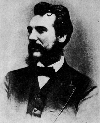![[PrevPage]](../prevpage.gif) |
![[Next]](../nextpage.gif) |
![[INDEX ]](../toc.gif) |
| |
Volume 1 |
24 Feb. 1876
|
Page 32
| | |
![[Source]](src.gif) |
![[ NOTES ]](../notes.gif) |
 |



- The spring S S (Figs 6 and 7) is glued to the membrane (m) and is
acted upon by the end of the cylinder C. I tried t with notes of
different pitches - and found that
the curves produced were always of the two-headed pattern. (see a b c
Fig 8). The Transmitting Instrument was a
small parlor organ with the reeds R (Fig 6)
arranged so as to make and break contact with a platinum point p when
vibrating.
- I think that probably the most sensitive kind of flame galvanometer
would be a
Receiving Instrument like R (Fig 5, p.19)
enclosed in a box which should be filled with gas. The flame at the burner should
vibrate when the spring vibrates.
![[PrevPage]](../prevpage.gif) |
![[Next]](../nextpage.gif) |
![[INDEX ]](../toc.gif) |
| |
Volume 1 |
24 Feb. 1876
|
Page 32
| | |
![[Source]](src.gif) |
![[ NOTES ]](../notes.gif) |
 |
![[PrevPage]](../prevpage.gif)
![[Next]](../nextpage.gif)
![[PrevPage]](../prevpage.gif)
![[Next]](../nextpage.gif)



![[PrevPage]](../prevpage.gif)
![[Next]](../nextpage.gif)